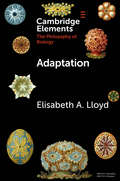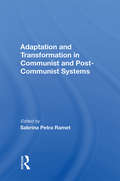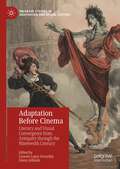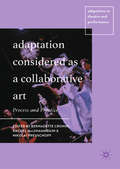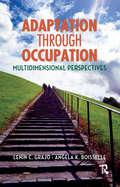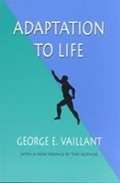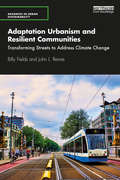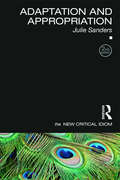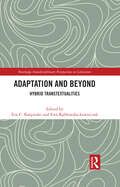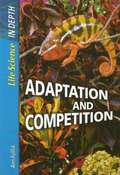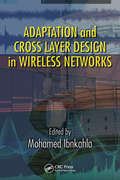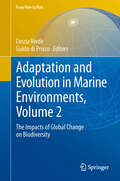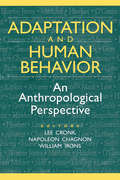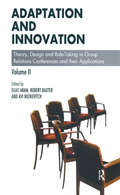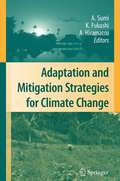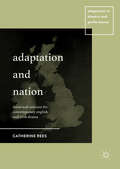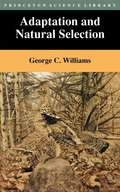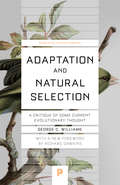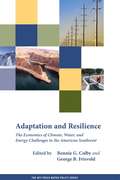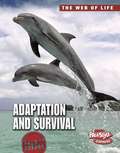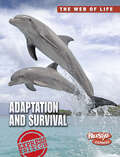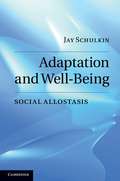- Table View
- List View
Adaptation (Elements in the Philosophy of Biology)
by Elisabeth LloydNatural selection causes adaptation, the fit between an organism and its environment. For example, the white and grey coloration of snowy owls living and breeding around the Arctic Circle provides camouflage from both predators and prey. In this Element, we explore a variety of such outcomes of the evolutionary process, including both adaptations and alternatives to adaptations, such as nonadaptive traits inherited from ancestors. We also explore how the concept of adaptation is used in evolutionary psychology and in animal behavior, and the adequacy of methods used to confirm evolutionary accounts of human traits and behaviors.
Adaptation And Transformation In Communist And Post-communist Systems
by Sabrina Petra RametThis book tackles different aspects of the adaptive and transformative process in communist and post-communist systems in Eastern Europe, offering competing models, which locate the explanatory variable in different places and account for the unfolding of change in different ways.
Adaptation Before Cinema: Literary and Visual Convergence from Antiquity through the Nineteenth Century (Palgrave Studies in Adaptation and Visual Culture)
by Lissette Lopez Szwydky Glenn JellenikAdaptation Before Cinema highlights a range of pre-cinematic media forms, including theater, novelization, painting and illustration, transmedia art, children’s media, and other literary and visual culture. The book expands the primary scholarly audience of adaptation studies from film and media scholars to literary scholars and cultural critics working across a range of historical periods, genres, forms, and media. In doing so, it underscores the creative diversity of cultural adaptation practiced before cinema came to dominate the critical conversation on adaptation. Collectively, the chapters construct critical bridges between literary history and contemporary media studies, foregrounding diverse practices of adaptation and providing a platform for innovative critical approaches to adaptation, appropriation, or transmedia storytelling popular from the Middle Ages through the invention of cinema. At the same time, they illustrate how these forms of adaptation not only influenced the cinematic adaptation industry of the twentieth century but also continue to inform adaptation practices in the twenty-first century transmedia landscape. Written by scholars with expertise in historical, literary, and cultural scholarship ranging from the medieval period through the nineteenth century, the chapters use discourses developed in contemporary adaptation studies to shed new lights on their respective historical fields, authors, and art forms.
Adaptation Considered as a Collaborative Art: Process and Practice (Adaptation in Theatre and Performance)
by Bernadette Cronin Rachel MagShamhráin Nikolai PreuschoffThis book examines the processes of adaptation across a number of intriguing case studies and media. Turning its attention from the 'what' to the 'how' of adaptation, it serves to re-situate the discourse of adaptation studies, moving away from the hypotheses that used to haunt it, such as fidelity, to questions of how texts, authors and other creative practitioners (always understood as a plurality) engage in dialogue with one another across cultures, media, languages, genders and time itself. With fifteen chapters across fields including fine art and theory, drama and theatre, and television, this interdisciplinary volume considers adaptation across the creative and performance arts, with a single focus on the collaborative.
Adaptation Of The Vessels Of The Western Gunboat Flotilla To The Circumstances Of Riverine Warfare: During The American Civil War
by Lt-Cmd Nicholas F. BuddThis study investigates the adaptation and purpose-built construction of the vessels used by the Federal government to conduct riverine warfare on the waters of the American Mississippi River drainage basin. The study concentrates on the technology, geography, hydrography, and convention which shaped the construction of the vessels comprising the Federal Western Gunboat Flotilla; an organization which after October 1862 became the United States Navy Mississippi Squadron.The ability of an organization to adapt is equipment to conditions encountered during wartime is often a contributing factor in ultimate victory or defeat. During the Civil War, the process adopted by the Navy to adapt and furnish vessels for its riverine force was flawed. This study emphasizes these facts and explores the response of the Navy chain of command to lessons learned in combat about the vulnerabilities of the vessels of the Western Gunboat Flotilla.The study is not intended as a treatise on tactics or the organization of the United States Navy. However, it does address both with regard to their effect on the performance and adaptation of the vessels of the Western Gunboat Flotilla.
Adaptation Through Occupation: Multidimensional Perspectives
by Lenin Grajo Angela BoisselleAdaptation, as an internal human process, is an often-overlooked construct in occupational therapy education, research, and practice. Adaptation Through Occupation: Multidimensional Perspectives aims to change that by presenting different perspectives that challenge the reader’s understanding of occupational adaptation. As the first of its kind text to explore, analyze, and present a comprehensive and multidimensional approach to understanding occupational adaptation, the collection of writings in this text add to the range of knowledge available in occupational therapy.Adaptation Through Occupation: Multidimensional Perspectives by Drs. Lenin Grajo and Angela Boisselle provides in-depth perspectives of occupation and adaptation that can be used to teach courses on foundational and theoretical perspectives in occupational therapy, occupational science undergraduate and graduate programs, and as a critical module in teaching Neuroscience to occupational therapy students. This text also aims to facilitate new bodies of research to define and apply the concept of adaptation in relation to occupational performance and participation.Some perspectives covered inside include: Historical and theoretical perspectives on occupation and adaptation Neural mechanisms of occupational adaptation Occupational science perspectives and international and lived-experience perspectives Included with the text are online supplemental materials for faculty use in the classroom.Adaptation Through Occupation: Multidimensional Perspectives opens the gates for new ways of understanding occupational adaptation and adds necessary information to the existing knowledge in the occupational therapy profession.
Adaptation To Life
by George E. VaillantBetween 1939 and 1942, one of America's leading universities recruited 268 of its healthiest and most promising undergraduates to participate in a revolutionary new study of the human life cycle. The originators of the program, which came to be known as the Grant Study, felt that medical research was too heavily weighted in the direction of disease, and their intent was to chart the ways in which a group of promising individuals coped with their lives over the course of many years. Nearly forty years later, George E. Vaillant, director of the Study, took the measure of the Grant Study men. The result was the compelling, provocative classic, Adaptation to Life, which poses fundamental questions about the individual differences in confronting life's stresses. Why do some of us cope so well with the portion life offers us, while others, who have had similar advantages (or disadvantages), cope badly or not at all? Are there ways we can effectively alter those patterns of behavior that make us unhappy, unhealthy, and unwise? George Vaillant discusses these and other questions in terms of a clearly defined scheme of "adaptive mechanisms" that are rated mature, neurotic, immature, or psychotic, and illustrates, with case histories, each method of coping.
Adaptation Urbanism and Resilient Communities: Transforming Streets to Address Climate Change (Advances in Urban Sustainability)
by John L. Renne Billy FieldsAdaptation Urbanism and Resilient Communities outlines and explains adaptation urbanism as a theoretical framework for understanding and evaluating resilience projects in cities and relates it to pressing contemporary policy issues related to urban climate change mitigation and adaptation. Through a series of detailed case studies, this book uncovers the promise and tensions of a new wave of resilient communities in Europe (Copenhagen, Rotterdam, and London), and the United States (New Orleans and South Florida). In addition, best practice projects in Amsterdam, Barcelona, Delft, Utrecht, and Vancouver are examined. The authors highlight how these communities are reinventing the role of streets and connecting public spaces in adapting to and mitigating climate change through green/blue infrastructure planning, maintaining and enhancing sustainable transportation options, and struggling to ensure equitable development for all residents. The case studies demonstrate that while there are some more universal aspects to encouraging adaptation urbanism, there are also important local characteristics that need to be both acknowledged and celebrated to help local communities thrive in the era of climate change. The book also provides key policy lessons and a roadmap for future research in adaptation urbanism. Advancing resilience policy discourse through multidisciplinary framework this work will be of great interest to students of urban planning, geography, transportation, landscape architecture, and environmental studies, as well as resilience practitioners around the world.
Adaptation and Appropriation (The New Critical Idiom)
by Julie SandersFrom the apparently simple adaptation of a text into film, theatre or a new literary work, to the more complex appropriation of style or meaning, it is arguable that all texts are somehow connected to a network of existing texts and art forms. In this new edition Adaptation and Appropriation explores: multiple definitions and practices of adaptation and appropriation the cultural and aesthetic politics behind the impulse to adapt the global and local dimensions of adaptation the impact of new digital technologies on ideas of making, originality and customization diverse ways in which contemporary literature, theatre, television and film adapt, revise and reimagine other works of art the impact on adaptation and appropriation of theoretical movements, including structuralism, post-structuralism, postcolonialism, postmodernism, feminism and gender studies the appropriation across time and across cultures of specific canonical texts, by Shakespeare, Dickens, and others, but also of literary archetypes such as myth or fairy tale. Ranging across genres and harnessing concepts from fields as diverse as musicology and the natural sciences, this volume brings clarity to the complex debates around adaptation and appropriation, offering a much-needed resource for those studying literature, film, media or culture.
Adaptation and Beyond: Hybrid Transtextualities (Routledge Interdisciplinary Perspectives on Literature)
by Eva C. Karpinski Ewa Kębłowska-ŁawniczakThis interdisciplinary collection focuses on recent adaptations, both experimental and popular, that put hybridity, transtextuality, and transmediality at play. It reframes adaptation in terms of the transmedia concept of "world-building," which accurately captures the complexity and multidirectionality of contemporary scattered and ubiquitous practices of adaptation. The Editors argue that the process of moving stories or their elements across different media platforms and repurposing them for new uses results in the production of hybrid transtextualities. The book demonstrate how hybrid textualities augment narrative and literary forms as goals of their world-building, finding unexpected sites of cross-pollination, expansion, and appropriation in spoken-word and dance performance, (auto)biographical comics, advertising, Chinese Kun opera, and popular song lyrics. This yoking of hybridity and transmediality yields not only diversified and often commercialized aesthetic forms but also enables the emergence a unique cultural space in-between, a mezzaterra capable of addressing current political issues and mobilizing broader audiences
Adaptation and Change On the Galapagos Islands
by Helen Sillett"The vampire finch and the sneaker iguana have something in common. They both live on the Galapagos Islands, a group of islands in the Pacific Ocean. These islands are a natural wonderland full of strange and amazing birds and animals. Some people have heard about the Galapagos because of the giant tortoises (turtles) that live there. Maybe you have seen these animals in a book or on television. The Galapagos Islands are also famous because of a young man named Charles Darwin, who visited them in 1835. Later, Darwin went on to become one of the most important scientists the world has ever known."-Introduction
Adaptation and Competition
by Ann FullickThese titles provide an in-depth look at life processes. The books stress key features of science teaching including scientific inquiry, use of ideas and evidence in science, planning, evaluation, and developing investigative skills. Sample experiments and data illustrate best practices in a real context. Case studies of key experiments and discoveries in the history of science are presented as box features (including modern discoveries as well as those with historical importance). Information on the most recent developments in research demonstrates the progressive nature of science.
Adaptation and Cross Layer Design in Wireless Networks
by Mohamed IbnkahlaAdaptive techniques play a key role in modern wireless communication systems. The concept of adaptation is emphasized in the Adaptation in Wireless Communications Series through a unified framework across all layers of the wireless protocol stack ranging from the physical layer to the application layer, and from cellular systems to next-generation wireless networks. Adaptation and Cross Layer Design in Wireless Networks is devoted to adaptation in the data link layer, network layer, and application layer. The book presents state-of-the-art adaptation techniques and methodologies, including cross-layer adaptation, joint signal processing, coding and networking, selfishness in mobile ad hoc networks, cooperative and opportunistic protocols, adaptation techniques for multimedia support, self –organizing routing, and tunable security services. It presents several new theoretical paradigms and analytical findings which are supported with various simulation and experimental results. Adaptation in wireless communications is needed in order to achieve high capacity and ubiquitous communications. The current trend in wireless communication systems is to make adaptation dependent upon the state of the relevant parameters in all layers of the system. Focusing on simplified cross layer design approaches, this volume describes advanced techniques such as adaptive resource management, adaptive modulation and coding, 4G communications, QoS, diversity combining, and energy and mobility aware MAC protocols. The first volume in the series, Adaptive Signal Processing in Wireless Communications (cat no.46012) covers adaptive signal processing at the physical layer.
Adaptation and Evolution in Marine Environments, Volume 1: The Impacts of Global Change on Biodiversity (From Pole to Pole)
by Guido Di Prisco Cinzia VerdeThe poles undergo climate changes exceeding those in the rest of the world in terms of their speed and extent, and have a key role in modulating the climate of the Earth. Ecosystems adapted to polar environments are likely to become vulnerable to climate changes. Their responses allow us to analyse and foresee the impact of changes at lower latitudes. We need to increase our knowledge of the polar marine fauna of continental shelves, slopes and deep sea, as identifying the responses of species and communities is crucial to establishing efficient strategies against threats to biodiversity, using international and cross-disciplinary approaches. The IPY 2007-2009 was a scientific milestone. The outstanding contribution of Marine Biology is reflected in this volume and the next one on "Adaptation and Evolution in Marine Environments - The Impacts of Global Change on Biodiversity" from the series "From Pole to Pole", making these volumes a unique and invaluable component of the scientific outcome of the IPY.
Adaptation and Human Behavior: An Anthropological Perspective (Evolutionary Foundations Of Human Behavior Ser.)
by Napoleon ChagnonThis volume presents state-of-the-art empirical studies working in a paradigm that has become known as human behavioral ecology. The emergence of this approach in anthropology was marked by publication by Aldine in 1979 of an earlier collection of studies edited by Chagnon and Irons entitled Evolutionary Biology and Human Social Behavior: An Anthropological Perspective. During the two decades that have passed since then, this innovative approach has matured and expanded into new areas that are explored here.The book opens with an introductory chapter by Chagnon and Irons tracing the origins of human behavioral ecology and its subsequent development. Subsequent chapters, written by both younger scholars and established researchers, cover a wide range of societies and topics organ-ized into six sections. The first section includes two chapters that provide historical background on the development of human behavioral ecology and com-pare it to two complementary approaches in the study of evolution and human behavior, evolutionary psychology, and dual inheritance theory. The second section includes five studies of mating efforts in a variety of societies from South America and Africa. The third section covers parenting, with five studies on soci-eties from Africa, Asia, and North America. The fourth section breaks somewhat with the tradition in human behavioral ecology by focusing on one particularly problematic issue, the demographic transition, using data from Europe, North America, and Asia. The fifth section includes studies of cooperation and helping behaviors, using data from societies in Micronesia and South America. The sixth and final section consists of a single chapter that places the volume in a broader critical and comparative context.The contributions to this volume demonstrate, with a high degree of theoretical and methodological sophistication--the maturity and freshness of this new paradigm in the study of human behavior. The volume will be of interest to anthropologists and other professions working on the study of cross-cultural human behavior.
Adaptation and Illustration: New Cartographies (Palgrave Studies in Adaptation and Visual Culture)
by Shannon Wells-Lassagne Sophie AymesThis collection examines the relationship between illustration and adaptation from an intermedial and transcultural perspective. It aims to foster a dialogue between two fields that co-exist without necessarily acknowledging advances in each other’s domains, providing an argument for defining illustration as a form of adaptation, as well as an intermedial practice that redefines what we mean by adaptation. The volume embraces both a specific and an extended definition of illustration that accounts for its inclusion among the web of adaptive practices that developed with the rise of new media and intermediality. The contributors explore how crossovers may contribute to reappraise their objects, and rely on a transmedial and interdisciplinary corpus exploring the boundaries between illustration and other media such as texts, graphic novels, comics, theatre, film and mobile applications. Arguably adaptation, like intermediality, is an umbrella term that covers a variety of practices and products, and both of them have been shaped by intense debates over their boundaries and internal definitions. Illustration belongs to each of these areas, and this volume proposes insight into how illustration not only relates to adaptation and intermediality but how each field is redefined, enriched and also challenged by such interactions.
Adaptation and Innovation: Theory, Design and Role-Taking in Group Relations Conferences and their Applications (The Group Relations Conferences Series)
by Eliat Aram Robert Baxter Avi NutkevitchThis book, the second in a series on Tavistock Group Relations Conferences, contains the collection of papers presented at the second Belgirate conference plus four additional papers reflecting on and making sense of several participants conference experiences. Taken together, these papers offer an exciting picture of the Group Relations enterprise as it continues to adapt and innovate its approaches to the practice of Group Relations conferences globally. It will be of interest to members of the group relations community as well as others who are agents of change and development in their professions and organisations, and who might use group relations thinking in their research, management, consultancy or educational roles.
Adaptation and Mitigation Strategies for Climate Change
by Ai Hiramatsu Kensuke Fukushi Akimasa SumiIn recent decades there has been a growing awareness of how intricate the interactions are between human beings and the environment. Fortunately, progress has been made in understanding this relationship, and new technologies have been effective in addressing environmental problems. However belatedly, there has been an acknowledgment of the incompatibility of the world's finite resources with humankind's increasingly greater needs for them, and of how such a challenge demands broadened collaboration among engineers, social scientists, politicians and financial powers. Global agreement that the essential issues of the twenty-first century cannot be solved by any one discipline has led to the concept of sustainability. The transdisciplinary contributions selected for inclusion in this book address these concerns with an overview of the diverse fields of study related to sustainability. This collection of work is intended to pave the way for further collaboration among scientists and nations as well.
Adaptation and Nation: Theatrical Contexts for Contemporary English and Irish Drama (Adaptation in Theatre and Performance)
by Catherine ReesThis book takes a novel approach to theatrical adaptation, focusing not primarily on filmic adaptations but instead on modern drama based on older, classic playtexts. The specific focus of the book is the exploration of the new national setting given to the reworked version. In exploring the way in which contemporary dramatists in England and Ireland represent a different national setting for their reworked adaptation, we can examine the specific social and political context for the new play, unearthing the cultural conditions at the time of the new setting. In examining only plays that consciously relocate the national setting for their new work, we can also explore resonances between the two different national contexts, analysing cultural and political echoes as well as shifts both geographical and temporal.
Adaptation and Natural Selection: A Critique of Some Current Evolutionary Thought
by George C. WilliamsBiological evolution is a fact--but the many conflicting theories of evolution remain controversial even today. In 1966, simple Darwinism, which holds that evolution functions primarily at the level of the individual organism, was threatened by opposing concepts such as group selection, a popular idea stating that evolution acts to select entire species rather than individuals. George Williams's famous argument in favor of the Darwinists struck a powerful blow to those in opposing camps. His Adaptation and Natural Selection, now a classic of science literature, is a thorough and convincing essay in defense of Darwinism; its suggestions for developing effective principles for dealing with the evolution debate and its relevance to many fields outside biology ensure the timelessness of this critical work.
Adaptation and Natural Selection: A Critique of Some Current Evolutionary Thought
by Richard Dawkins George C. WilliamsBiological evolution is a fact—but the many conflicting theories of evolution remain controversial even today. When Adaptation and Natural Selection was first published in 1966, it struck a powerful blow against those who argued for the concept of group selection—the idea that evolution acts to select entire species rather than individuals. Williams’s famous work in favor of simple Darwinism over group selection has become a classic of science literature, valued for its thorough and convincing argument and its relevance to many fields outside of biology. Now with a new foreword by Richard Dawkins, Adaptation and Natural Selection is an essential text for understanding the nature of scientific debate.
Adaptation and Resilience: The Economics of Climate, Water, and Energy Challenges in the American Southwest (RFF Press Water Policy Series)
by Bonnie G. Colby George B. FrisvoldIn America�s arid southwest, climate change will occur in the context of already-keen competition for water for agriculture, urban growth, electricity generation, water-based recreation, and environmental protections. This book explores the challenges that climate change and variability pose for water and energy managers and users, communities, and policy makers in the arid Southwest and demonstrates the application of economic methods to address these challenges. It provides valuable tools for both those interested in resource management and climate change, and those seeking to understand how economic methods can be used to analyze contemporary social problems and craft appropriate responses. The book considers both adaptation to long-term climate change and more immediate issues of water and electricity management in the face of inter-annual climate variability and drought. Thus, no matter what one�s perspective on long-run climate change projections, the book provides useful lessons for some of the region�s most pressing resource management problems.
Adaptation and Survival
by Robert SneddenThe book explains how living things develop features to adapt themselves to their environment, improve their chances of survival and also about the natural selection process.
Adaptation and Survival (The\web Of Life Ser.)
by Robert SneddenWhy do tigers have stripes? Do they choose to have them, or is that just how they are? Adaptation and Survival explains what is meant by the fitness of an organism and shows how adaptations improve a plant or animal's chances of survival to have offspring. It tackles common confusions about the science and shows how topics are relevant to the reader.
Adaptation and Well-Being
by Jay SchulkinRecently, an interest in our understanding of well-being within the context of competition and cooperation has re-emerged within the biological and neural sciences. Given that we are social animals, our well-being is tightly linked to interactions with others. Pro-social behavior establishes and sustains human contact, contributing to well-being. Adaptation and Well-Being is about the evolution and biological importance of social contact. Social sensibility is an essential feature of our central nervous systems, and what have evolved are elaborate behavioral ways in which to sustain and maintain the physiological and endocrine systems that underlie behavioral adaptations. Writing for his fellow academics, and with chapters on evolutionary aspects, chemical messengers and social neuroendocrinology among others, Jay Schulkin explores this fascinating field of behavioral neuroscience.
